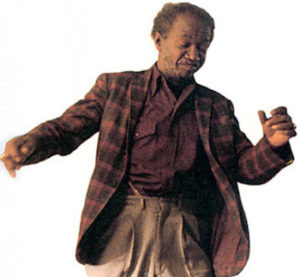
Sandman Sims
*Sandman Sims was born on this date in 1917. He was a Black tap dancer.
Howard "Sandman" Sims was born in Fort Smith, Arkansas, one of 12 children. The family soon relocated to Los Angeles, California, where he was raised. Sims described his childhood as "just a big dancing family." He learned to dance from his father, and he said he was dancing as soon as he could walk and began tap dancing at the age of 3.
He attributed some of his early love for tap dancing, in particular, to his mother, who was exasperated that he kept wearing out the toes of his shoes and put steel taps on them. Along with his brothers, Sims was dancing on the sidewalks of Los Angeles from a young age. At 14, peeping in the windows of a dance school got Sims arrested for loitering, but he could dance his way to freedom, convincing a judge that his reason for being on that street was legitimate.
As a young man, Sims aspired to be a professional boxer. After twice breaking his hand, he noticed that boxing audiences reacted positively to how he would dance in the rosin box before getting into the ring, especially to the distinctive sound his dancing made moving the rosin granules around the wooden box. He began considering dancing as a career alternative and started his career in vaudeville. Sims experimented with several methods of reproducing the rosin box effect, such as gluing sandpaper to his shoes or dancing mat. Still, the sandpaper created too much wear on the other surface. Finally, he found the solution: loose sand in a low-lipped box. "People went for the scraping sound, so I made a soundboard by sprinkling sand on a flat platform. That was in 1935."
His sandbox remained his trademark throughout his career, with some venues telling Sims, "If you don't bring your sandbox, don't come at all." During this period, it was common for dancers to carry tap shoes with them and, when they encountered another dancer on the street, throw down their shoes by way of challenge. The culture of street dancing in the 1920s has been compared to the rise of break dancing six decades later. As the journal Jump Cut described, "'Challenge Dancing,' in which each performer tries to outdo the other, is part of tap dancing's heritage, something like the jazz solos in which musicians try to outshine one another."
Sims later described how the atmosphere of these dance challenges was at least as collegial as combative and how dancers learned from one another in what became essentially "open-air dance schools." Despite performing at various vaudeville venues, Sims found neither fame nor success as a dancer in Los Angeles. In 1947, he tagged along on one of his boxer friends Archie Moore's cross-country drives and settled in New York City.
From the 1950s to 2000, Sims was a regular attraction at the Apollo Theater, comedically ushering failed acts offstage with a hook, broom, or other props. He was also involved in New York City's Hoofers Club, a venue primarily for black tap dancers. As part of the resurgence of interest in tap dancing in the 1980s, Sandman Sims served as a cultural ambassador, representing the United States with dance performances worldwide. He was featured in the 1989 dance film Tap, along with Sammy Davis Jr., Gregory Hines, and Savion Glover, demonstrating classic challenge dancing. Sims also appeared in a 1990 episode of The Cosby Show as Rudy's tap-dancing teacher, facing off against Cliff (Bill Cosby) in a good-natured tap challenge.
In her review of the play based on his life, New York Times critic Anna Kisselgoff wrote, "Sims is a virtuoso among virtuosos—in a class by himself. To say Mr. Sims dances on sand is like saying Philippe Petit [the French high wire who gained fame from his illegal walk between the two World Trade Center towers in 1974] is a tightrope walker." On April 5, 2000, he was invoked by Huey Freeman in the comic strip The Boondocks, who responded to an ineptly told joke by saying, "Where is Sandman Sims when you need him ..." Performance artist Holly Bass, along with other dancers, put on another play about Sims's life at the Smithsonian Institution's American History Museum (which was then hosting an exhibit on the Apollo Theater) on July 10, 2010.
President Barack Obama, referring to his performance singing on the Apollo Theater stage (albeit not on Amateur Night) the evening before his 2012 State of the Union address, said, "Sandman did not come out!" Sims’s first marriage produced his first child, Diane Sims; he later married his second wife, Solange. They would have a son, Howard Sims Jr., five grandchildren, and a great-grandchild. In later years, Sims sometimes claimed not to be certain of his birth year, saying it was "a matter of opinion." Asked by a fan how old he was, Sims once replied, "Any number can play." Howard "Sandman" Sims died in New York City on May 20, 2003. He had had Alzheimer's disease. A memorial service for Sims was held at the Apollo Theater. He was skilled in a style of dancing that he performed in a wooden sandbox of his construction and acquired his nickname from the sand he sprinkled to alter and amplify the sound of his dance steps.